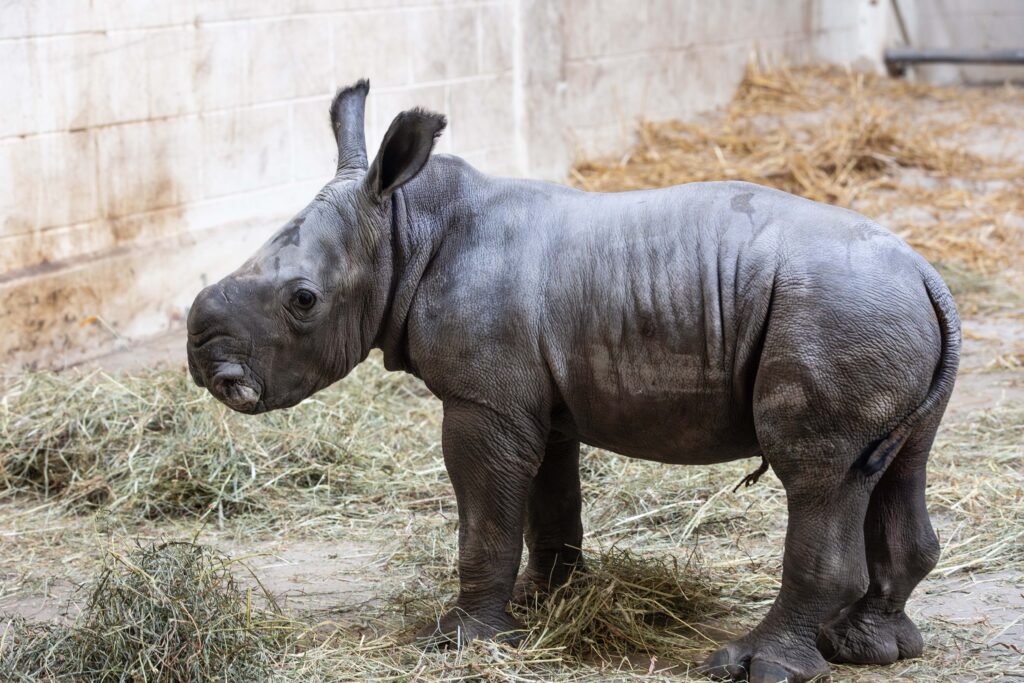Southern white rhinoceros with rare genetics born at Virginia Zoo

The Virginia Zoo is thrilled to announce the birth of a female southern white rhinoceros on November 9, 2023 at 5:40 a.m., bringing our crash up to five. The calf, named Letti, is the second rhinoceros ever born at the Virginia Zoo and the second offspring to 17-year-old father Sibindi and 10-year-old mother Zina, who birthed the Zoo’s first rhino calf, Mosi, in 2021.
“Zina is an incredible mom and while she is still very protective of her calf, she is much calmer around the staff than she was with her first, which is a true testament to how hard the Africa team works to bond with the animals within their care,” Emily Spence, Assistant Curator of Africa, stated. “The team is enjoying watching the baby’s personality come through more and more each day and can’t wait to share her with zoo guests.”
A neonatal exam was performed within 48 hours of the birth, confirming the baby is a healthy female weighing about 100 lbs. Zina and the new baby will remain in their night barn for the next few weeks in order for their keepers to monitor them and ensure they are bonding, but they can be seen through the barn windows.
When our Africa keepers learned the calf was a female, they wanted to name her after a powerful female who is making a difference in saving wildlife, just as this baby will make a difference in the future conservation of her species. Letti’s name is inspired by Sergeant Nkateko Letti Mzimba, a ranger with The Black Mambas, the first all-female, anti-poaching organization in South Africa. Sgt. Mzimba was recently named 2023’s Best Field Ranger in Africa for her passionate efforts to protect rhinos and other wildlife species, as well as her work to educate surrounding communities on the importance of conservation.
“Naming an animal, especially one of the most popular species in a zoo, is such an important thing because it has the potential to reach many people with a positive message and create healthy dialogue,” Spence said. “Sgt. Mzimba is truly an inspiration not only for her hard work, but also for excelling as a female in a typically male-dominated industry.”
Zina and Sibindi are a recommended breeding pair by the Association of Zoos and Aquariums’ (AZA) White Rhino Species Survival Plan® (SSP), which helps to ensure genetic diversity and the continued growth of the southern white rhino population in AZA accredited facilities. The new calf, who will be named by her keepers at a later date, and Mosi’s genetics are considered especially valuable due to their parents’ origin. Zina was born at the Singapore Zoo in 2013 and Sibindi was born in South Africa in 2006. The birth of these offspring marks the first time their genetics have been represented in an American zoo.
Southern white rhinos are native to South Africa, where they are found almost exclusively, and have been introduced to Botswana, Namibia, Zimbabwe and Eswatini. They have been classified as Near Threatened by the International Union for Conservation of Nature (IUCN), with poaching for their horns being the largest threat to them in the wild. This threat has already resulted in extinction and near-extinction of other rhino species.
“This baby is invaluable to the long-term survival of the species.” Greg Bockheim, Executive Director of the Virginia Zoo, said. “And like her older brother, she could not be more adorable.”
Our Africa keeper team hopes the name ‘Letti’ will bringing awareness to the Black Mambas and other organizations doing the on-the-ground work to protect wildlife in Africa, while inspiring young women to chase their passions and stand up for what they believe in.
In the wild, southern white rhinos’ median life expectancy is about 36 years, but they may live to be older than 40 in human care. The gestation period averages around 16 months, the second longest in the animal kingdom behind elephants.
White rhinos are not actually white in color. Their name comes from the Afrikaans word wyd, meaning “wide”, which references the animals’ mouth shape but was misinterpreted by early English settlers as “white.”